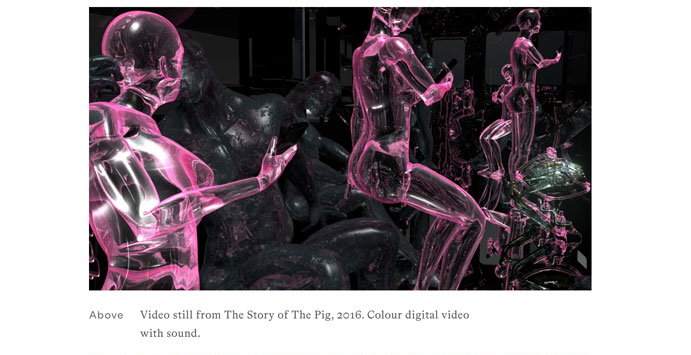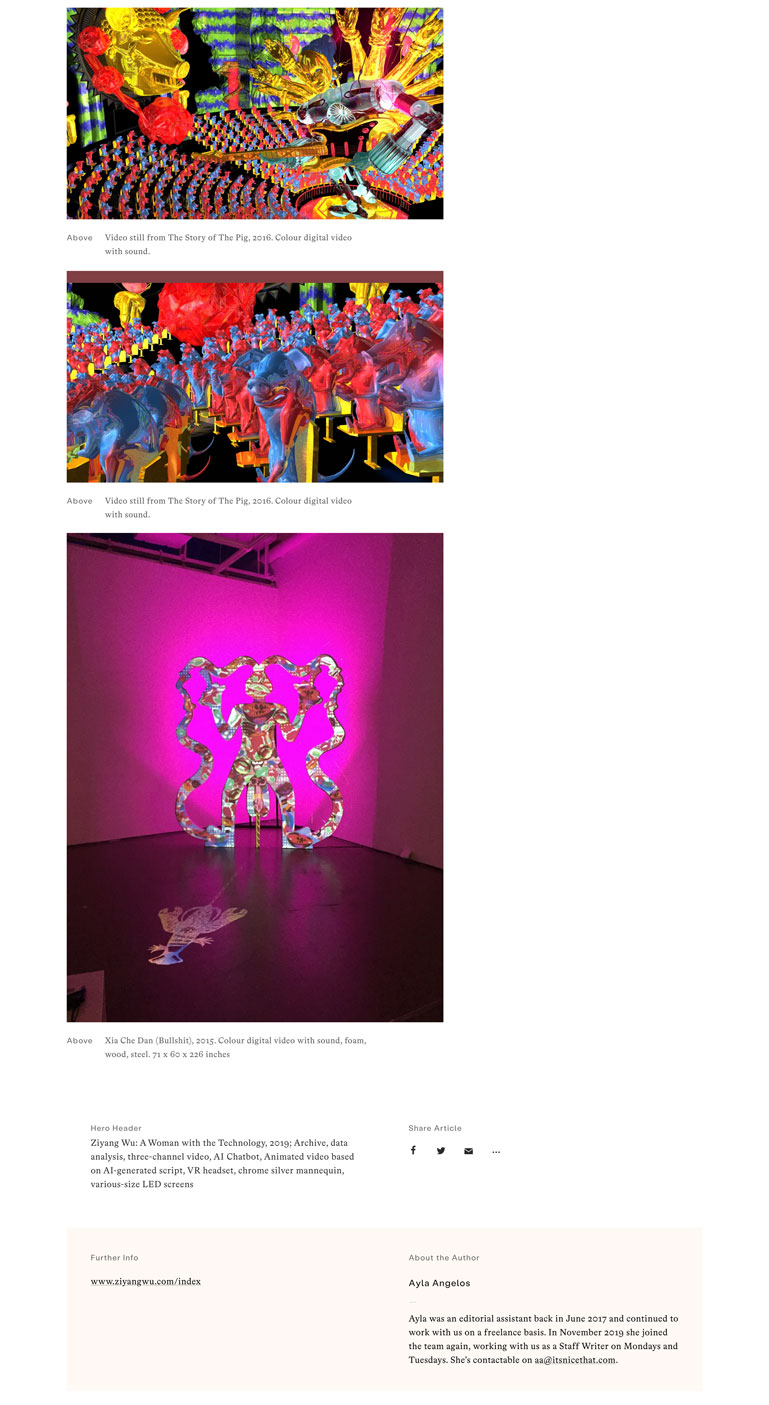Through Post-Internet Projects, Artist Ziyang Wu Paints An Important (And Scary) Picture of The Future
The Chinese artist, currently based in New York, runs us through his future-focused work and most recent project, A Woman with the Technology.
22 May 2020
Ayla Angelos
https://www.itsnicethat.com/articles/ziyang-wu-a-woman-with-the-technology-digital-220520
To understand a bit more about what it is that Ziyang Wu actually does, it’s important to take note of two prominent experiences growing up. The first, is that his father was a first-generation contemporary Chinese artist and an “integral part of the 1985 New Wave Art movement and the 1989 China/Avant-garde”. Having quit art in 1992 to become a businessman selling soy milk, Ziyang used to accompany him on his trips across China; every city they visited, they always went downtown in the evening to pee in the middle of the road. Leaving their trace, his father would say: “This is our way of being creative and subversive”, Ziyang recalls.
The second experience involved Ziyang being sent to live with a Buddhist grandma for three years, because of his parents becoming increasingly busy with work. Here, he would go to the temple and practice Buddhist changing everyday, “without knowing what it was about,” he tells It’s Nice That. “I was simply following the rules, mimicking their behaviours while consistently questioning what it was for.” As two influential parts of his life, Ziyang explains how these are just two examples of how his experiences have “prepared” him for a world full of artistic expression, as well as the “skepticism in a certain established system” and an interest in “hybrid cultural experiences”.
Born and raised in Xuzhou, Jiangsu Province, China, the artist now current resides in New York where he teaches as the School of Visual Arts, and is a member of the Experiment on Art and Technology Track at NEW INC, New Museum. After graduating from high school, Ziyang went on to study traditional Renaissance painting techniques in Florence, before venturing to the US for his graduate studies at RISD in 2014. During his studies – although specialising in painting – he would also experiment with various other mediums, including sculpture, video, performance, VR, AR, interactive installation and AI simulation. And it was this blend of the old and new, of technology and analogue that really took a hold of Ziyang and his practice.

Ziyang now describes his work as “post-internet micro-alienation”, for his ability to deep-dive into “contemporary technology, digital power structures, popular culture, the dynamics between identity and community, as well as the alienation of an individual’s spirit and body.” Although in some ways difficult to comprehend, it’s imperative to see his work as more of an exploration into humanity, and its relationship with tech and the effect of a hyper-connected, globalised world. As such, he considers himself a project-based artist, often drawing his ideas from an event, a specific moment or an emotion.
When the moment strikes, he will begin his research phase – a critical part which involves an innate study of philosophy and data collecting. In comparison to the ideation phase, his video production process is “very intuitive”, and tends to begin with building 3D models of characters and scenes based on the script – using 3D modelling through MAYA, 3D painting and sculpting through Master piece VR and Tilt Brush. “Most of the focus at this stage is related to aesthetics,” he says, before moving on to texture design and animating, then motion capture, footage shooting and camera tracking, ending with the final phase of editing.
The conversation now steers onto his most recent project, A Woman with the Technology. With a concept themed on the ways in which an individual’s online experience becomes personalised by the internet algorithm, Ziyang refers to internet activist Eli Pariser’s coined phrase, the ‘filter bubble’. Filled with recordings, archive material, videos and AI-generated script, he adds: “As a result of the filter bubble, users become separated from information that disagrees with their viewpoints, effectively isolating them in their own cultural and ideological bubbles.” Moments like browsing a product online and noticing the same targeted adds in all areas of the internet is what he strives to recreate here, alongside “ubiquitous algorithmic manipulation in daily life”.

Research and data collection plays a vital role throughout his work. A Woman with the Technology, is in fact spawned from his own personal experiences – like when he started to receive related posts and videos about Democrat presidential candidate Andrew Yand, plus information related to LGBTQ, Asian American and African communities. Targeted as a “reconstruction” of ‘him’, it’s relevant (and scary) topic indeed, what with the current circulation of fake news and advertisements populating the internet as we speak. When asked what’s in store for the future, Ziyang paints an important picture. “Imagine in 10 years, when we are shopping for groceries in the supermarket; the facial recognition at the entrance can immediately know all of your purchase records. According to the amount of remaining food in your refrigerator and weather of the day, the freshness of food, the price and what you like, the system will customise a series of purchase options of you immediately (an upgraded version of the ‘filter bubble’ of the internet).
“There are great advantages in terms of efficiency, nutrition and shopping experiences,” he concludes. “But on the other hand – which is what many of my projects try to explore – is the negative impact and manipulation that the algorithm has on people. All of our consumption choices are filtered by algorithms nowadays and there’s almost no way to escape from them.”



